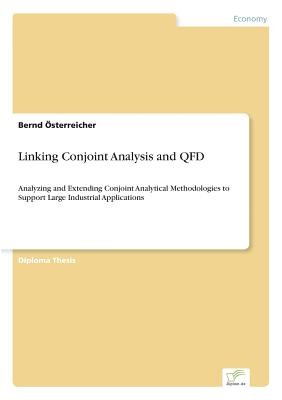
- We will send in 10–14 business days.
- Author: Bernd Ãsterreicher
- Publisher: Diplom.de
- Year: 1999
- Pages: 224
- ISBN-10: 3838616677
- ISBN-13: 9783838616674
- Format: 14.8 x 21 x 1.3 cm, softcover
- Language: English
- SAVE -10% with code: EXTRA
Reviews
Description
Inhaltsangabe: Zusammenfassung: Die vorliegende Arbeit (in Englisch) beschäftigt sich mit der Integration der Methodik Conjointanalyse (CA) in den Quality Function Deployment ProzeÃ, um den QFD-Prozeà in Entscheidungs- und Bewertungssituationen zu unterstützen. Im Mittelpunkt steht dabei die Untersuchung der gängigen Conjointmethoden auf Anwendbarkeit und Eignung für groà angelegte Studien, wie z. B. QFD-Anwendungen. Detailliert wird dabei auf eine Erweiterung oder Unterstützung der Conjointanalyse eingegangen, um eine Vielzahl an Merkmalen und Merkmalsausprägungen (Kundenanforderungen) berücksichtigen zu können. Die kommerzielle Anwendung der einzelnen Methodiken, eine Fragebogenauswertung sowie ein Vergleich von 21 CA- und 3 der bekanntesten QFD Software-tools runden diese Arbeit ab. Abstract: This paper is structured into 5 chapters: Chapter 1 contains an introduction into the problem area and the aim of the thesis. Moreover, it gives a survey of the procedure to reach the target of extending and supporting several Conjoint Analysis methodologies to be able for an integration into the Quality Function Deployment approach with its huge amount of customer requirements (attributes and levels). Chapter 2 shows the integration of Conjoint Analysis and Quality Function Deployment into the Total Quality Management concept as quality improving, customer orientated (key word mass customization), and cost reducing tools. The importance to support Quality Function Deployment by Conjoint Analysis is pointed out to lead over to the main chapter of the paper. Chapter 3 is dedicated to several Conjoint Analysis models and the way in which to extend and support these methods, so that an integration into a large industrial study such as a Quality Function Deployment application can take place without any problems. To this purpose several conjoint techniques are described in detail, are extended by further techniques, and are compared to each other concerning their validit
EXTRA 10 % discount with code: EXTRA
The promotion ends in 18d.17:01:34
The discount code is valid when purchasing from 10 €. Discounts do not stack.
- Author: Bernd Ãsterreicher
- Publisher: Diplom.de
- Year: 1999
- Pages: 224
- ISBN-10: 3838616677
- ISBN-13: 9783838616674
- Format: 14.8 x 21 x 1.3 cm, softcover
- Language: English English
Inhaltsangabe: Zusammenfassung: Die vorliegende Arbeit (in Englisch) beschäftigt sich mit der Integration der Methodik Conjointanalyse (CA) in den Quality Function Deployment ProzeÃ, um den QFD-Prozeà in Entscheidungs- und Bewertungssituationen zu unterstützen. Im Mittelpunkt steht dabei die Untersuchung der gängigen Conjointmethoden auf Anwendbarkeit und Eignung für groà angelegte Studien, wie z. B. QFD-Anwendungen. Detailliert wird dabei auf eine Erweiterung oder Unterstützung der Conjointanalyse eingegangen, um eine Vielzahl an Merkmalen und Merkmalsausprägungen (Kundenanforderungen) berücksichtigen zu können. Die kommerzielle Anwendung der einzelnen Methodiken, eine Fragebogenauswertung sowie ein Vergleich von 21 CA- und 3 der bekanntesten QFD Software-tools runden diese Arbeit ab. Abstract: This paper is structured into 5 chapters: Chapter 1 contains an introduction into the problem area and the aim of the thesis. Moreover, it gives a survey of the procedure to reach the target of extending and supporting several Conjoint Analysis methodologies to be able for an integration into the Quality Function Deployment approach with its huge amount of customer requirements (attributes and levels). Chapter 2 shows the integration of Conjoint Analysis and Quality Function Deployment into the Total Quality Management concept as quality improving, customer orientated (key word mass customization), and cost reducing tools. The importance to support Quality Function Deployment by Conjoint Analysis is pointed out to lead over to the main chapter of the paper. Chapter 3 is dedicated to several Conjoint Analysis models and the way in which to extend and support these methods, so that an integration into a large industrial study such as a Quality Function Deployment application can take place without any problems. To this purpose several conjoint techniques are described in detail, are extended by further techniques, and are compared to each other concerning their validit


Reviews